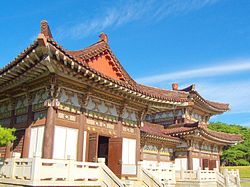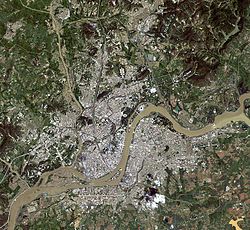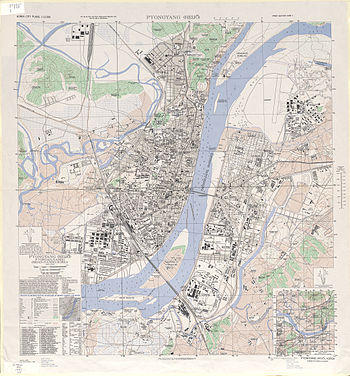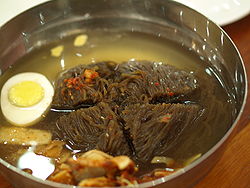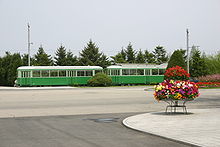
Pyongyang
About this schools Wikipedia selection
Arranging a Wikipedia selection for schools in the developing world without internet was an initiative by SOS Children. Visit the SOS Children website at http://www.soschildren.org/
|
||||||||||||||||||||||||||||||||||||||||||||
Pyongyang ( 평양, Korean pronunciation: [pʰjɔŋjaŋ], literally: "Flat Land") is the capital of the Democratic People's Republic of Korea, commonly known as North Korea, and the largest city in the country. Pyongyang is located on the Taedong River and, according to preliminary results from the 2008 population census, has a population of 3,255,388. The city was split from the South P'yŏngan province in 1946. It is administered as a directly governed city (chikhalsi), on the same level as provincial governments, not a special city (teukbyeolsi) as Seoul is in South Korea.
Etymology
"Pyongyang" means literally "Flat Land", in Korean. One of Pyongyang's many historic names is Ryugyong (류경; 柳京), or "capital of willows", as willow trees have always been numerous throughout the city's history, and many poems have been written about these willows. Even today, the city has numerous willow trees, with many buildings and places having "Ryugyŏng" in their names. The most notable of these is the uncompleted Ryugyong Hotel. The city's other historic names include Kisong, Hwangsong, Rakrang, Sŏgyong, Sodo, Hogyong, and Changan. During the early 20th century, Pyongyang came to be known among missionaries as being the "Jerusalem of the East", due to its historical status as being a stronghold of Christianity, namely Protestantism.
Prehistory
In 1955, archaeologists excavated evidence of prehistoric occupation in a large ancient village called Kŭmtan-ni, in the Pyongyang area, from the Chŭlmun and Mumun pottery periods. North Koreans associate Pyongyang with " Asadal" (아사달; 신시), or Wanggomsŏng (왕검성; 王儉城), the first capital (second millennium BC) of the Gojoseon kingdom according to Korean history books, notably Samguk Yusa. Many South Korean historians deny this claim, because other Korean history books place Asadal around the Liao River located in western Manchuria. Also, such may have been asserted by North Korea for the use of propaganda. Nevertheless, Pyongyang became a major city under Gojoseon.
History
It is likely that the area of Pyongyang belonged to Wiman Joseon, the longest-lasting part of Gojoseon, which fell in the Gojoseon–Han War in 108 BC. Emperor Wu of the Han Dynasty ordered four commanderies set up, with Lelang Commandery in the centre, and its capital established as "Pingrang" (平壤), or "Pyongyang". Several archaeological findings from the Later Eastern Han (25-220) periods in the Pyongyang area seems to suggest that Han forces later launched brief incursions around the area of Pyongyang.
The area around Pyongyang was called Nanglang during the early Three Kingdoms period. As the capital of Nanglang kingdom (낙랑국; 낙랑), Pyongyang remained an important commercial and cultural outpost after Lelang Commandery was destroyed by an expanding Goguryeo in 313.
Goguryeo moved its capital here in 427. According to Christopher Beckwith, Pyongyang is the Sino-Korean reading of the name they gave it in their language, Piarna, or "level land".
In 668, Pyongyang became the capital of the Protectorate General to Pacify the East, established by the Tang Dynasty of China. However, by 676, Pyongyang was taken by Silla but left on the border between Silla and Balhae (Bohai) until the time of the Goryeo dynasty, when the city was revived as Sŏgyŏng ( Hangul: 서경; Hanja: 西京; "Western Capital"), although it was never actually a capital of Goryeo. It was the provincial capital of the Pyeongan Province during the Joseon dynasty.
The importance of Pyongyang declined in the late 16th century, when the Japanese conquered it, and the city was further damaged when it was overrun by the Manchus early in the 17th century. After the invaders left, Korea withdrew from international contact, and Pyongyang, like other Korean cities, was largely closed to the outside world for nearly three centuries.
In the 19th century, Pyongyang became a base for Protestant missionaries in the country. The city soon had the largest Christian population in Korea and by 1890 it was reported that Pyongyang had more than 100 churches, most of which were Protestant.
In 1890, the city had 40,000 inhabitants. It was the site of an important battle during the First Sino-Japanese War, which led to the destruction and depopulation of much of the city. However, it was the provincial capital of South Pyeongan Province from 1896. Under colonial rule, the city became an industrial centre, known in Japanese as Heijō. By 1938, Pyongyang had a population of 235,000.
In 1945, the 25th army of the Soviet Army entered Pyongyang, and it became the temporary capital of Provisional People's Committee for North Korea. Pyongyang Commercial School was on Mansudae Hill, with the provincial government building behind. The provincial building was one of the finest buildings in Pyongyang. The Soviet Armed Forces assigned it as their headquarters and allotted City Hall to North Korean officials, while the Communist Party's headquarters were assigned to the Revenue Office. It became the de facto capital of the Democratic People's Republic of Korea at its establishment in 1948. At that time, the Pyongyang government aimed to recapture Korea's official capital at that time, Seoul. Pyongyang was again severely damaged in the Korean War, during which it was briefly occupied by South Korean forces. In 1952, it was the target of the largest aerial raid of the entire war, involving 1,400 UN aircraft. After the war, the city was quickly rebuilt with Soviet aid, with many buildings built in Socialist Classicism. The rebuilt city featured extensive parks, broad boulevards, and high-rise apartments. Pyongyang became the political, economic, and transportation centre of North Korea. In 1962, the city had a population of 653,000. The population grew to 1.3 million in 1978 and to more than 3 million by 2007.
Geography and climate
| Pyongyang | ||||||||||||||||||||||||||||||||||||||||||||||||||||||||||||
|---|---|---|---|---|---|---|---|---|---|---|---|---|---|---|---|---|---|---|---|---|---|---|---|---|---|---|---|---|---|---|---|---|---|---|---|---|---|---|---|---|---|---|---|---|---|---|---|---|---|---|---|---|---|---|---|---|---|---|---|---|
| Climate chart ( explanation) | ||||||||||||||||||||||||||||||||||||||||||||||||||||||||||||
|
||||||||||||||||||||||||||||||||||||||||||||||||||||||||||||
|
||||||||||||||||||||||||||||||||||||||||||||||||||||||||||||
Pyongyang is located in west-central part of North Korea; the city lies on a flat plain about 50 kilometres (31 mi) east of the Korea Bay, an arm of the Yellow Sea. The Taedong River flows southwestward through the city toward the Korea Bay.
Pyongyang has a humid continental climate ( Köppen climate classification Dwa). Cold, dry winds can blow from Siberia in winter, making conditions very cold; the low temperature is usually below freezing between November and early March, although the average daytime high is a few degrees above freezing in every month except January. The winter is generally much drier than summer, with snow falling for 37 days on average.
The transition from the cold, dry winter to the warm, wet summer occurs rather quickly between April and early May, and there is a similar abrupt return to winter conditions in late October and November. Summers are generally hot and humid, with the East Asian monsoon taking place from June until August; these are also the hottest months, with average temperatures of 21 to 25 °C (70 to 77 °F), and daytime highs often above 30 °C (86 °F).
| Climate data for Pyongyang (1971–2000) | |||||||||||||
|---|---|---|---|---|---|---|---|---|---|---|---|---|---|
| Month | Jan | Feb | Mar | Apr | May | Jun | Jul | Aug | Sep | Oct | Nov | Dec | Year |
| Average high °C (°F) | −0.8 (30.6) |
2.4 (36.3) |
8.9 (48) |
17.1 (62.8) |
22.6 (72.7) |
26.7 (80.1) |
28.6 (83.5) |
28.9 (84) |
24.7 (76.5) |
18.2 (64.8) |
9.4 (48.9) |
1.7 (35.1) |
15.7 (60.3) |
| Average low °C (°F) | −10.7 (12.7) |
−7.8 (18) |
−1.8 (28.8) |
4.9 (40.8) |
10.9 (51.6) |
16.5 (61.7) |
20.7 (69.3) |
20.5 (68.9) |
14.3 (57.7) |
6.7 (44.1) |
−0.3 (31.5) |
−7.2 (19) |
5.6 (42.1) |
| Precipitation mm (inches) | 12.2 (0.48) |
11.0 (0.433) |
24.7 (0.972) |
49.9 (1.965) |
72.2 (2.843) |
90.3 (3.555) |
275.2 (10.835) |
212.8 (8.378) |
100.2 (3.945) |
39.9 (1.571) |
34.9 (1.374) |
16.5 (0.65) |
939.8 (37) |
| Avg. precipitation days | 5.2 | 4.2 | 5.1 | 6.7 | 8.1 | 8.7 | 14.4 | 11.0 | 7.2 | 6.1 | 7.3 | 5.9 | 89.9 |
| Source: World Meteorological Organisation | |||||||||||||
Administrative status and divisions
For the first few decades of North Korea’s history, Pyongyang was not officially considered the capital of the country. The North Korean government officially regarded itself the sole legitimate government of the entire Korean peninsula, so until 1972, the North Korean Constitution designated Seoul as the country's capital. According to the official discourse of the time, Seoul was considered to be under the occupation of the American forces and their South Korean client. Pyongyang, in this scheme of things, was merely the provisional headquarters of the peninsula’s sole government, to be used only until the eventual liberation of Seoul. In 1972, Pyongyang was officially promoted to the status of national capital.
P'yŏngyang is divided into 18 wards (ku- or guyŏk) (the city proper) and 2 counties (kun or gun).
|
|
Foreign media reports in 2010 stated that Kangnam-gun, Chunghwa-gun, Sangwŏn-gun, and Sŭngho-guyŏk had been transferred to the administration of neighboring North Hwanghae province.
Culture
Landmarks
The capital has been completely redesigned since the Korean War (1950–1953). It is designed with wide avenues, imposing monuments and monolithic buildings. The tallest structure in the city is the uncompleted 330-metre (1,083 ft) Ryugyŏng Hotel. This hotel has 105 floors and encloses 361,000 square metres (3,885,772 sq ft) of floor space. The original plan called for crowning it with seven revolving restaurants.
Notable landmarks in the city include:
- the Kumsusan Palace of the Sun
- the Arch of Triumph (heavily inspired by but larger than Paris's Arc de Triomphe)
- the reputed birthplace of Kim Il-sung at Mangyongdae Hill at the city outskirts
- Juche Tower
- two large stadiums:
- Rungrado May Day Stadium
- Kim Il Sung Stadium
- the Mansu Hill complex
- Kim Il-sung Square
- Yanggakdo International Hotel.
Pyongyang TV Tower is a minor landmark. Other visitor attractions include the Korea Central Zoo. The Arch of Reunification has a map of a united Korea supported by two concrete Korean women dressed in traditional dress straddling the Reunification Highway, which stretches from Pyongyang to the Korean Demilitarized Zone (DMZ).
As of 2011 current construction includes a claimed 100,000 new homes in the city, including a large project along Changjeon Street. This is the top construction priority and uses KPA soldiers as labor. Supposedly construction plans began after Kim Jong Il described the area as "pitiful".
Cuisine
Pyongyang served as the provincial capital of Pyeongan province until 1946, and Pyongyang cuisine shares the general culinary tradition of the Pyeongan province. The most famous local food is Pyongyang naengmyeon, or also called mul naengmyeon or just simply naengmyeon. Naengmyeon literally means "cold noodles", while the affix mul refers to "water" because the dish is served in a cold broth. Naengmyeon consists of thin and chewy buckwheat noodles in a cold meat-broth with dongchimi (watery kimchi) and topped with a slice of sweet Korean pear. Pyongyang naengmyeon was originally eaten in homes built with ondol (traditional underfloor heating) during the cold winter, so it is also humorously called "Pyongyang deoldeori" (shivering in Pyongyang). Pyongyang locals sometimes enjoyed it as a haejangguk, which is any type of food eaten as a hangover-cure, usually a warm soup.
Another representative Pyongyang dish, Taedonggang sungeoguk, translates as "trout soup from the Taedong River". The soup features trout (abundant in the Taedong River) along with black peppercorns and salt. It is served as a courtesy to important guests visiting Pyongyang. Therefore, the question, "How good was the trout soup?" is commonly used to greet people returning from Pyongyang. Another local specialty, Pyongyang onban (literally "warm rice of Pyongyang") comprises freshly-cooked rice topped with sliced mushrooms, chicken, and a couple of bindaetteok (pancakes made from ground mung beans and vegetables).
Famous restaurants in the city include Okryugwan and Ch'ongryugwan.
Sports
Pyongyang has a number of sports clubs, including the April 25 Sports Club and the Pyongyang City Sports Club. The most popular sport in Pyongyang is Association football (soccer).
Transportation
Domestic trains
Pyongyang railway station serves the main railway lines, including the Pyongui Line and the Pyongbu Line.
International trains
The city also has regular international rail services to Beijing and Moscow. A journey to Beijing takes about 25 hours and 25 minutes (K27 from Beijing/K28 from Pyongyang, on Mondays, Wednesdays, Thursdays and Saturdays); a journey to Moscow takes 6 days. The city also connects to the Eurasian Land Bridge via the Trans-Siberian Railway.
Metro and bus
The Pyongyang Metro is a two-line underground metro system which has a length of 22.5 km (14.0 mi). The Hyoksin line serves Kwangbok, Konguk, Hwanggumbol, Konsol, Hyoksin, Jonu, Jonsung, Samhung and Rakwon stations. The Chollima line serves Puhung, Yonggwang, Ponghwa, Sungni, Tongil, Kaeson, Jonu and Pulgunbyol stations.
There is also a 53 km (33 mi) long Pyongyang tram system and a 150 km (93 mi) Pyongyang trolleybus system. The trolley bus-stops are fairly busy.
Cars
There are few cars in the city, cars being a symbol of status in the country due to their scarcity as a result of restrictions on import because of international sanctions and domestic regulations. The scarcity of fuel makes the cost of using cars prohibitive. In addition, some roads are in a poor condition.
Air
State-owned Air Koryo has scheduled flights from Pyongyang Sunan International Airport to Beijing ( PEK), Shenyang ( SHE), Vladivostok ( VVO), Moscow ( SVO), Bangkok ( BKK), Khabarovsk ( KHV), Kuala Lumpur ( KUL), Shanghai ( PVG) and Kuwait City ( KWI)
Air Koryo also operates limited scheduled service to a few domestic destinations. The only domestic destinations are Hamhung, Wonsan, Chongjin, Hyesan and Samjiyon. In April 2008, Air China launched a regular service between Beijing and Pyongyang.
Another airport, Mirim Airport is located in the east of the city. It appears to have fallen into disuse.
Hotels
Pyongyang has two major operating hotels: the Yanggakdo International Hotel and the Koryo Hotel. The Ryugyeong Hotel is scheduled to open in mid-2013. The Ryguyeong Hotel is the tallest building in North Korea. The Yanggakdo Hotel is the second tallest. The Yanggakdo, Koryo and Ryugyeong hotels are designed to cater to foreign tourists. Other hotels include the: Taedonggang Hotel, Ryanggang Hotel, Moranbong Hotel, Haebangsan Hotel, and Sosan Hotel.
Retail
Pyongyang is home to several large department stores including: Pyongyang Department Store No. 1, Pyongyang Department Store No. 2, Kwangbok Department Store, Ragwon Department Store, Pyongyang Station Department Store and the Pyongyang Children’s Department Store.
Sister cities
 Jakarta, Indonesia
Jakarta, Indonesia Kathmandu, Nepal
Kathmandu, Nepal Tianjin, People's Republic of China
Tianjin, People's Republic of China


